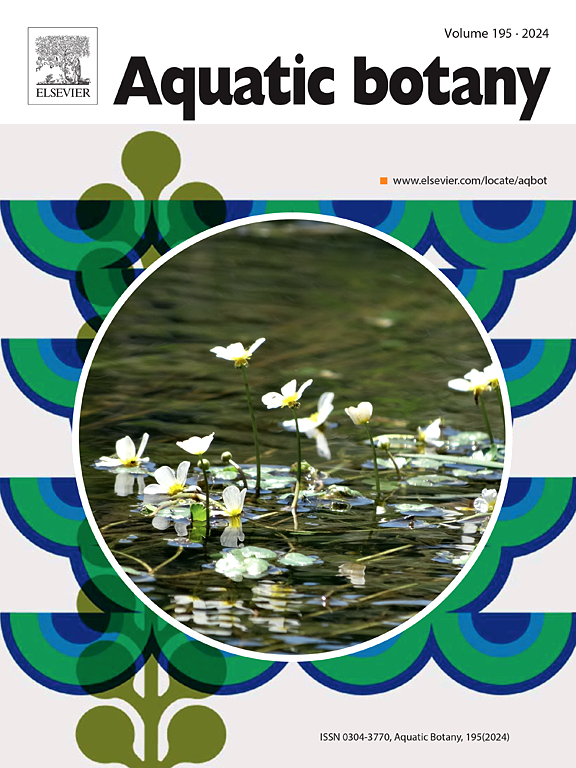不同的菱锰矿石群栖息着不同的伴生物种,但具有相似的生态群:地中海西北部案例研究
IF 2.6
4区 生物学
Q2 MARINE & FRESHWATER BIOLOGY
引用次数: 0
摘要
菱锰矿床是沿岸碎屑岩底层中分布最广、研究最多的岩层,其特征是有大量的活的包壳生物。在地中海,已描述了四种红柱石层:i) 箱形红柱石;ii) 马埃尔石;iii) 棱柱石;iv) 无附着的佩松内藻类。虽然已经公布了与地中海菱锰矿床相关的物种清单,但还没有与不同菱锰矿面相关的物种之间的比较。本文比较了在托斯卡纳群岛(意大利)采样的与上述四个菱锰矿岩层相关的物种。这些岩相与已发现的 12 种红柱石物种(10 种 Corallinales 和 2 种钙化 Peyssonneliales)中的大多数物种相同,但丰度不同。只有 3 个相关物种(共 377 个)在所有 4 个菱锰矿组合中具有共性,但它们都具有沿海碎屑岩底部生物群落特有的物种生态群丰富的特点。因此,用生态群组而不是物种组成来描述红岩面貌更为恰当。要推广这一结果,还需要在地中海其他海域进行类似的研究,并对其他巨石面(即珊瑚石和红柱石)进行比较研究。本文章由计算机程序翻译,如有差异,请以英文原文为准。
Different rhodolith assemblages host distinct associated species but similar ecological groups: A case study in NW Mediterranean Sea
Rhodolith beds represent the most widespread and studied facies of the coastal detrital bottoms characterized by macroids of living encrusting organisms. In the Mediterranean Sea, four rhodolith facies have been described: i) boxwork rhodoliths; ii) maërl; iii) pralines; and iv) unattached Peyssonneliales. Although lists of species associated with Mediterranean rhodolith beds have been published, no comparison among the species associated with different rhodolith facies are available. This paper compares the species associated with the four above-mentioned rhodolith facies sampled in the Tuscan Archipelago (Italy). These facies shared most of the 12 rhodolith species identified (10 Corallinales and 2 calcified Peyssonneliales), but with different abundances. Only three associated species (out of 377) were common to all four rhodolith assemblages, which however were all characterized by the abundance of the ecological group of the species characteristic of the biocoenosis of the Coastal Detrital bottoms. Therefore, rhodolith facies were better described in terms of ecological groups rather than species composition. Similar studies in other sectors of the Mediterranean Sea are needed to generalize this result, and the comparative study of other macroid facies, namely coralliths and bryoliths, would also be of interest.
求助全文
通过发布文献求助,成功后即可免费获取论文全文。
去求助
来源期刊

Aquatic Botany
生物-海洋与淡水生物学
CiteScore
3.80
自引率
5.60%
发文量
70
审稿时长
6 months
期刊介绍:
Aquatic Botany offers a platform for papers relevant to a broad international readership on fundamental and applied aspects of marine and freshwater macroscopic plants in a context of ecology or environmental biology. This includes molecular, biochemical and physiological aspects of macroscopic aquatic plants as well as the classification, structure, function, dynamics and ecological interactions in plant-dominated aquatic communities and ecosystems. It is an outlet for papers dealing with research on the consequences of disturbance and stressors (e.g. environmental fluctuations and climate change, pollution, grazing and pathogens), use and management of aquatic plants (plant production and decomposition, commercial harvest, plant control) and the conservation of aquatic plant communities (breeding, transplantation and restoration). Specialized publications on certain rare taxa or papers on aquatic macroscopic plants from under-represented regions in the world can also find their place, subject to editor evaluation. Studies on fungi or microalgae will remain outside the scope of Aquatic Botany.
 求助内容:
求助内容: 应助结果提醒方式:
应助结果提醒方式:


